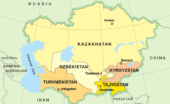Johannah Bernstein post: "eternally proud of my father’s extraordinary aeronautical engineering. legacy. here is a photo of the Canadair Water…
Wednesday Night #1326 – Postscript: More on Arctic Claims
Written by Diana Thebaud Nicholson // May 29, 2009 // Arctic and Antarctic, Russia, U.S., Wednesday Nights // 3 Comments
The Arctic’s oil reserves mapped
(BBC) An estimated 30% of the world’s undiscovered gas and 13% of its undiscovered oil may be in the Arctic, according to a map published on Friday. According to the new map, the majority of oil is likely to be found underwater, on continental shelves. Surrounding nations, including Russia, United States, Canada, Denmark and Norway, have all already sought to assert their jurisdiction over parts of the Arctic.
11 September 2008
New battle over Arctic oil plans
(BBC) The grey waters of the Arctic Ocean are the scene for a new battle over plans for a huge expansion in the drilling of oil and gas far beyond the Alaskan shore.
The governor of Alaska, Sarah Palin, in her speech accepting her nomination as Republican Party candidate for vice-president last week, said the country needed to produce more of its own oil and gas.
Executives from the oil giant Shell, whose multi-billion dollar plans have been held up by court actions brought by environmental campaigners, are now optimistic that public opinion is shifting their way.
July 23-24 2008
Arctic holds vast unexplored petroleum reserves
In the first assessment done on the region, the U.S. Geological Survey has revealed that the Arctic Circle holds as much as 90 billion barrels of recoverable oil — 13% of global reserves, or enough crude to power the world for three years. The amount only becomes more easily recoverable as global warming melts Arctic ice sheets, which in turn has accelerated the race among polar nations such as Canada, Russia, Denmark, Norway and the U.S. to stake their claims — the UN Law of the Sea Convention notwithstanding. The Arctic Circle is also said to hold some 1,700 trillion cubic feet of natural gas. Financial Times (7/23) , Reuters (7/24)
Blustering bruin
Russia’s Bear Is Back, With A Little Cash To Burn And A Lot Of Swagger To Bruit About
Chris Wattie, National Post
August 10, 2007
From the vast expanses of the Pacific to the icy reaches of the Arctic, the Russian bear is back and playing its Cold War game of aerial cat and mouse with U.S., British and Canadian fighter aircraft.NATO officials have noted a growing number of long-range missions by Russian Tupolev-95 bombers — the lumbering, turboprop aircraft known by the NATO code name “Bear” — including a flight over the U.S. Navy base on the Pacific island of Guam this week and a probe of British airspace over the North Sea last month.
In the Canadian Arctic and off the ice-bound northern coast of Alaska, meanwhile, Russian bombers never really stopped flying up to the edge of Canadian and U.S. airspace to test the radar and fighter responses of NORAD.
After the collapse of the Soviet Union, those flights dwindled to once or twice a year as the Russian armed forces were starved of funding, trained aircrew and mechanics and new equipment. But with the Russian military getting an infusion of resources and an apparent mandate to revive Russian power and prestige, NORAD pilots and ground controllers are bracing for more visits from the powerful four-engine bombers, which can carry nuclear weapons and air-launched cruise missiles.
While the resumption of the long-range flights up to–and occasionally into — NATO airspace is causing concern in allied circles, Russian generals are boasting openly about the latest flexing of their country’s growing military muscle.
A Bear bomber flew over a U.S. military base on the Pacific island of Guam this week and “exchanged smiles” with U.S. pilots who had scrambled to track it, said Major-General Pavel Androsov, head of long-range aviation in the Russian air force.
Maj.-Gen. Androsov told a news conference in Moscow yesterday that the 13-hour flight to Guam was part of a “tradition of our long-range aviation, to fly far into the ocean, to meet [U.S.] aircraft carriers and greet [U.S. pilots] visually.”
“Yesterday we revived this tradition,” he said. “I think the result was good. We met our colleagues — fighter jet pilots from [U.S.] aircraft carriers. We exchanged smiles and returned home.”
Maj.-Gen. Androsov said his bombers will be spending more time in the air and promised more long-range missions thanks to increased funding from Vladimir Putin ….The general said that under Mr. Putin long-range aviation is no longer short of fuel, enjoys better maintenance and much higher wages .
Lt.-Gen. Khvorov said the West will have to come to terms with Russia asserting its geopolitical power around the globe. “But I don’t see anything unusual; this is business as usual,” he said.
Earlier this month, RAF Tornado fighters were twice forced to scramble after Tu-95 bombers flew close to British airspace. Russia’s most senior admirals have also called for the establishment of a permanent naval base in the Mediterranean–likely at the Syrian port of Tartus — for the first time since the Cold War.
It was all reminiscent of the height of the Cold War when the Soviets would routinely send their massive Bear bombers up to the edge of U.S., Canadian or other NATO nations’ airspace.
In the Arctic in particular, U.S. and Canadian fighters were routinely scrambled — sometimes up to several times a month — to meet and shadow the Russian aircraft as they flew along the northern borders.
John Thompson, president of the Mackenzie Institute, a defence and security think-tank based in Toronto, said the Russians appear determined to repeat the mistakes of the Soviets. “The Soviet Union collapsed because they couldn’t afford the military that they had built up,” he said.
“Now the Russians have a bit of money and a lot of attitude and they’re making the same mistake: They’re spending more on their military and trying to act like a superpower … but they can’t afford it. It’s posturing.”
Mr. Thompson said the incursions by Russian bombers do not pose a direct threat to NATO nations, in part because the Russian military — particularly its air force– is still saddled with Soviet-era equipment, including the Bear bombers, which are more than 40 years old and are expected to remain in service for at least another 30. “There’s probably no aircraft in the world that’s as noisy or has as big a radar signature,” he said. “So I don’t know what they’re trying to accomplish by all these flights.”
But any increase in Arctic flights by the Russians could undermine Canadian claims to much of the North.
Canada cannot shrug off any increase in Russian activity in the North, Mr. Thompson said. “If you don’t go up and escort those bombers out of your airspace, then they start to act like they own that airspace,” he said.
But even as the Russians are rebuilding their bomber fleet, the Canadian air force has been downsizing.
The Canadian Forces is in the final stages of a multi-million-dollar modernization program for its CF-18 Hornet fighter jets …. But only 80 of the air force’s 100 fighters are being modernized and one of Canada’s four fighter squadrons has already been shut down.



3 Comments on "Wednesday Night #1326 – Postscript: More on Arctic Claims"
After Russia and Canada, US Ship Headed for Arctic
WASHINGTON – A US Coast Guard cutter is headed to the Arctic this week on a mapping mission to determine whether part of this area can be considered US territory, after recent polar forays by Russia and Canada.
The four-week cruise of the Coast Guard Cutter Healy starts Friday and aims to map the sea floor on the northern Chukchi Cap, an underwater plateau that extends from Alaska’s North Slope some 500 miles (805 km) northward.
This is the third such US Arctic mapping cruise — others were in 2003 and 2004 — and is not a response to a Russian mission this month to place a flag at the North Pole seabed, or a newly announced Canadian plan for an Arctic port, US scientists said.
Russia goes for Pole at ice station Putin
Eric Posner, professor of law at the University of Chicago, concluded that the small print of international maritime agreements was likely to prove irrelevant in the Arctic. “Power, not international law, will settle the issue,” he said. “Russia’s expression of power is credible; Canada’s is not.”
Diana, Excellent post
I think the characterization by Maj.-Gen. Androsov of the “dance” between NATO and Russian forces you have described here is important to note. US forces have played these games with the Russians for decades, in the air and on the seas. During the Vietnam War period, we would encounter an occasional Russian commercial ship in the open ocean and play a game of chicken. Inevitably, if there was a Russian ship within radar range, we would be on a collision course. I can tell you, our US Navy tradition then was to never change course. It’s scary stuff, and there’s great risk. A big difference today is the Internet, and your voice. What do you think Canada, the US and NATO should be doing differently in the Arctic? Regards